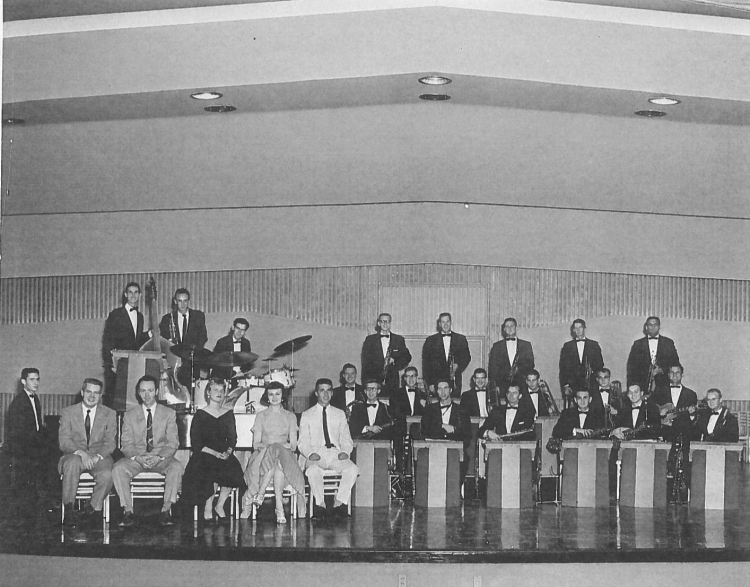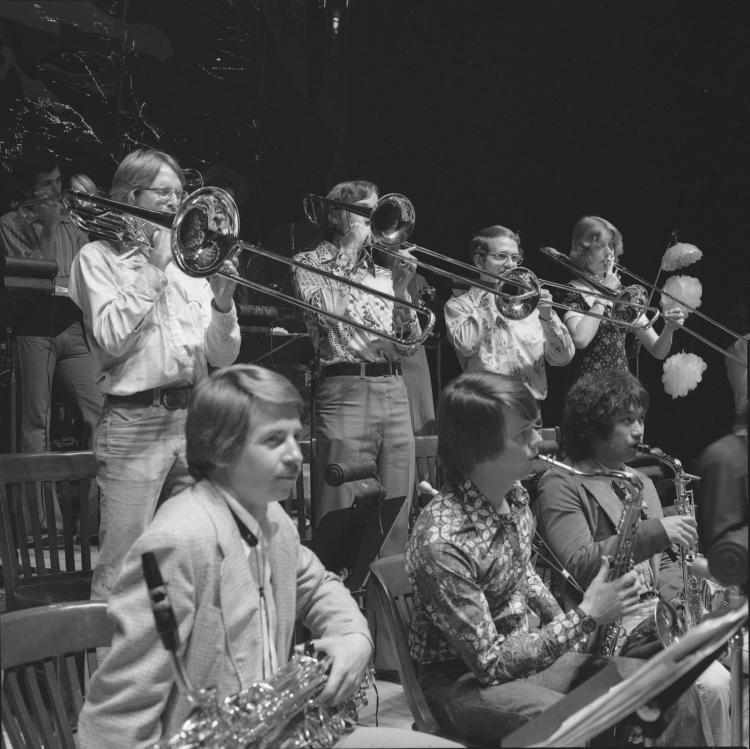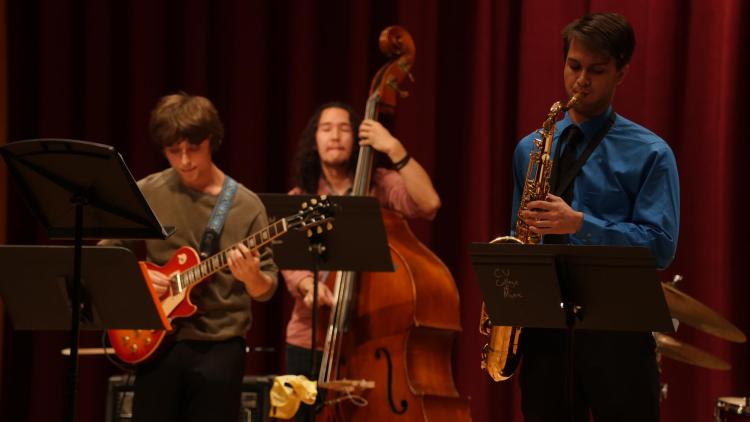The humble beginnings of jazz at CU Boulder
With renowned faculty, award-winning student ensembles and trailblazing alumni performing weekly throughout the jazz clubs of Denver and Boulder, the Thompson Jazz Studies Program is firmly on the front lines of jazz along the Front Range of the Rocky Mountains. Students from around the world seek out the program for its diverse offerings, professional opportunities and guest artist mentoring from the likes of Rufus Reid and Nnenna Freelon.
But that wasn’t always the case. For decades after jazz started to waft west from the Mississippi delta, there was no established jazz program at CU Boulder to speak of. Early pioneers had to form their own ensembles and play gigs around Boulder. And not surprisingly, jazz at CU had its humble beginnings at the hands of students who would become of the college’s most well-known alumni.
Just getting started
Even early on, vocalist Valorie Goodall knew a good thing when she heard it.
“I didn’t have a background in jazz. Country music was all I heard on the radio. But the jazz they were playing in Boulder was right up my alley, so I enjoyed listening to it. It was a whole experience, hanging out with interesting people listening to interesting music.”
Goodall graduated with a master’s degree in vocal performance in 1959, before going on to establish the opera program at Rutgers University. But while she was a student in Boulder in the 1950s, the Texas native was a big fan of the local jazz scene, drawn in by her roommate Angela Tillotson and Angela’s boyfriend (and future husband) Jim Coons.

The College Dance Band, which played jazz and big band tunes, in the 1950s.
She remembers vividly the restaurants around the area where they’d play: The Hearth. The Lamp Post.
“We’d have to drive out to listen to them. [Academy Award and Grammy winner] Dave Grusin (BM ’56) was a big part of the scene. Everyone knew who Dave was, even then.”
Donna Spencer Wilcox, who hails from eastern Colorado, often sang with pianist Grusin, along with performing in the Soft Winds trio with bassist Coons and guitarist Bob Draves.
“I met Dave in Estes Park in the summer of 1953. He was playing piano at the Stanley Hotel and he got me a job waiting tables there. I was a lousy waitress, but it was sure fun to be there and sing with Dave.”
Wilcox was part of some of the first jazz performances at the college, led by trailblazing faculty member Wayne Scott.
“Back then we were the College Dance Band, and all those guys—Jim, Bob, Terry Hannum, Jack Fredericksen—that was how they played jazz at the college.”
Wilcox never graduated; she was at CU for a semester before having to leave to take care of her mother. But the experience was formative.
“I met [my husband] John because of the jazz scene in Boulder, so that was a huge influence. After I left Boulder, through a connection of Dave’s, I was hired to sing the jingle for a Bubble Up soft drink commercial.
“I think that the music in Boulder no doubt helped me tremendously.”
Finding footing
As that first class of jazz artists began to move on, Wayne Scott continued to nurture the budding jazz presence at the College of Music. On a regional scale, more artists began to recognize Boulder and Denver for their jazz chops in the 60s as well. Then the one “true American art form” finally began to be recognized at the College of Music.
Steve Christopher was a freshman music education major in 1963 when he had his first rehearsal with Wayne Scott’s jazz ensemble.
“It was still taboo then. Our rehearsals were over the noon hour and for no class credit.”
Christopher, who went on to direct music programs at Boulder Valley Schools for more than 40 years, came to CU with some jazz experience under his belt. He and a group of friends from Boulder High School were already performing around town as The Blue Notes.
“We had no organized program in high school, it was just a few of us playing, so we were glad to have Scotty there with us to make it a real thing.”
A few years after Wayne Scott retired, John Weigardt took over the jazz ensemble. That’s when Christopher says things started to heat up.
“He took us all over the region to perform in festivals,” Christopher says. “We went to Reno, Salt Lake City, Greeley and more. He was responsible for that movement, and that really got us on the map.”

A jazz ensemble plays a concert in the 1970s.
Other early members of the faculty—Jerry Smith, Phil Aaholm and Jack Foot—continued to lay the foundation for things to come, beginning with the big band and history of jazz courses.
Over the course of the next 40 years, the program continued to grow, with alumni like Tia Fuller (MM ’00) and Willie Hill (MME ’72, Phd ’97) and current faculty members such as Tom Myer, Terry Sawchuk and Doug Walter further raising the standing of jazz at CU. By 1999, when current associate dean for operations and faculty affairs John Davis took over the program, the pendulum had really begun to swing.
“When I was at the University of Northern Colorado, which is a jazz giant in this state, I always thought CU would be a great place to direct the jazz studies program because of the potential,” Davis says. “It was around the time that I was hired—and when we hired the ferociously good pianist Chip Stephans at the end of Spring 2000—that the pivot began to happen."
Shortly after that, the program hired its third full-time faculty member, Brad Goode, which allowed the college to expand its jazz offerings from a master’s program to include a doctoral degree.
“And that put us on the map because we were one of only 10 or 11 programs in the nation to offer a doctoral degree,” Davis says.
Recognition from the chancellor allowed for the hiring of several adjunct faculty and the establishment of a bachelor’s degree in jazz studies. Then in 2013, two familiar faces to the Boulder music scene decided to take the program to new heights.
“Jack and I wanted to support the college in a more meaningful way,” says alumna Jeannie Thompson (BS ’64). “So [Dean Emeritus] Dan Sher suggested we give to the jazz program, which was winning awards and growing fast.”
Jack and Jeannie Thompson endowed and named the jazz program—the first named program on the CU Boulder campus. Jazz at CU now had the financial and emotional support of two notable alumni—and there was no looking back.
Forging ahead
With 19 Downbeat Magazine Award and countless other accolades to its name, CU Boulder’s jazz program has truly come into its own in recent years.
“The fact that jazz wasn’t even welcome in practice rooms a few decades ago, and then became the first named program at CU, is significant and reflects just how far things have come,” Davis says.
John Gunther, a Colorado native who came to the College of Music in 2005 and has led the program since 2014, has helped usher in a new era of excellence, bringing the annual Mile High Jazz Festival to Macky Auditorium and leading outreach trips to Costa Rica and the Next Generation Festival in Monterey, California. He says without the support of CU alumni and the Boulder community, none of it would have happened.

A jazz combo performs on the Grusin Music Hall stage in 2017.
“It’s helped us bring in amazing guest artists—people who represent the highest standard of what’s going on in the jazz world,” Gunther says. “We’ve also been able to get students and faculty into the recording studio every year, and it has of course helped grow our reputation nationally.”
As Gunther looks to the future, continued gigs in the area more professional recordings and travel with student ensembles shine bright on the horizon as the reputation of the Thompson Jazz Studies Program grows.
“We’re looking for ways we can expand the network of the department by going to conferences or doing outreach so that our students have opportunities internationally and nationally.
“We also want to continue to connect with our alumni, both as a resource for them and our current students.”
And alumni can look on with pride.
“This area is a mecca now for jazz. Denver is a fine jazz town. So it’s valuable and very important that we have a strong jazz program at CU and that we’re able to recruit the best students,” Thompson says.
“Jazz is a part of American music history,” Goodall adds. “We need to honor and embrace and support it, so it’s great that CU is leading the charge in that.”


